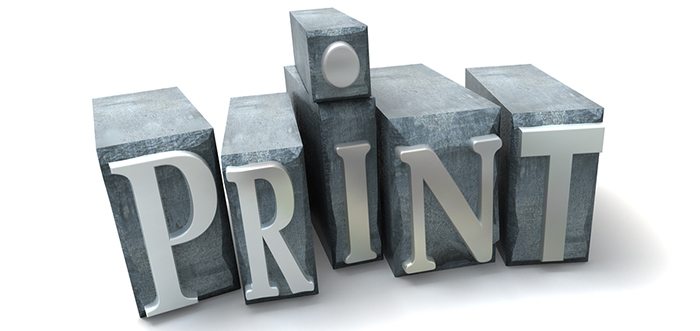
by Roberto Blake
Print Design is one of the more challenging aspects of being a graphic designer. There is more to it than the pixels of digital and web design. You have to consider the digital print production process and how the types of media you are printing on effect and impact design decisions. You also need to understand what requirements the printer has and avoid putting them in a position to have to correct your files. Mistakes in print are more costly and time consuming than mistakes in digital.
You have to think about things like ink color density, bleeding print to edges and other considerations as a print designer.
Modern digital print production is also a challenge for instructors because many of them have not used the latest versions of the software to do this themselves in the real world so don’t know how to translate this knowledge to their students when preparing documents for print.
When working with a printer it is important to remember that a successful print job starts with laying out your document properly and paying attention to the details. It could be something as simple as not preparing the document to the final trim size. If this is not done correctly the printer will have to reduce it and this can lead to problems like type not being large enough to read.
While PDF workflows are becoming the standard, sometimes it could be helpful to provide the native files as a package from Adobe InDesign or Quark and embed the fonts and provide the image links and assets. This can put the printer in the best position to address any issues that may come up with a document.
When printers have to correct the work of designers, a lot can go wrong. The end results may not meet the clients needs, deadline or budget, and this can spell disaster for the client relationship. So it’s a good idea to build strong relationships with printers and learn as much as you can about the print production process in order to be successful. Resources like PrintMediaCentr can definitely help you get a better grasp of the Print Universe and all it entails.
 Roberto Blake is a Graphic Designer who runs his own one man Design Studio, focusing on Brand Development and Advertising. Roberto has experience in design for print, web and multimedia and has worked on out of home campaigns including billboards featured in Times Square. He is a monthly contributor to Print Media Centr’s News From The Printerverse, and a frequent participant at #PrintChat on Twitter. He is also a contributor for publications such as Print Magazine and How Design and has had work featured in Advanced Photoshop Magazine. Roberto is extremely active in social media, producing multiple YouTube videos each week to assist designers and other creative professionals through advice and tutorials.
Roberto Blake is a Graphic Designer who runs his own one man Design Studio, focusing on Brand Development and Advertising. Roberto has experience in design for print, web and multimedia and has worked on out of home campaigns including billboards featured in Times Square. He is a monthly contributor to Print Media Centr’s News From The Printerverse, and a frequent participant at #PrintChat on Twitter. He is also a contributor for publications such as Print Magazine and How Design and has had work featured in Advanced Photoshop Magazine. Roberto is extremely active in social media, producing multiple YouTube videos each week to assist designers and other creative professionals through advice and tutorials.
Connect with Roberto: robertoblake.com / @robertoblake / [email protected]












3 Responses
Hi Roberto. This is cool stuff! Just what young, beginning graphic designers need to learn before sending their files to print. As with any printshop,we encounter a lot of problem files daily, as evidently,a lot of graphic design students were never exposed to the actual print process in school. I hope you can come out with easy to understand tips on how to design work that will print flawlessly.
I”m currently writing a paper for my Bachelors program about how it’s important for schools to implement print setup and design in the associates program. I was wondering if you had any further knowledge I could use? I’m using this article as one of my resources, but as a design student working in a print shop, I feel very strongly about this topic. I went into my job at the print shop blindly, even though I had my associates when I started. I don’t feel this is fair to the printer or the designer. They should work cohesively.
Roberto Blake wrote this post. You can find him on LinkedIn and YouTube 🙂